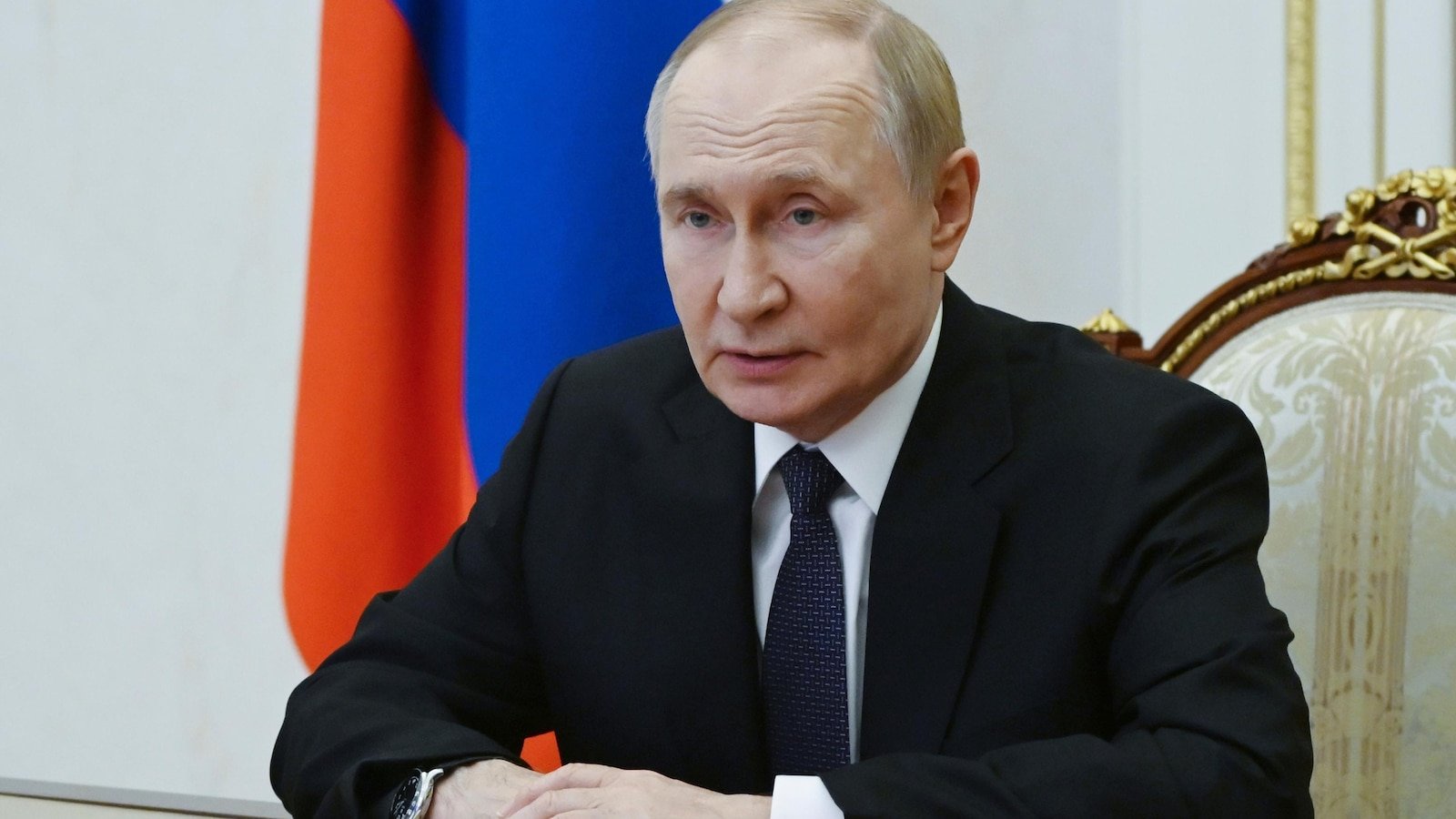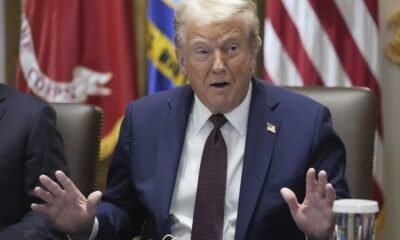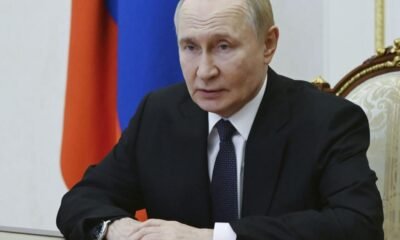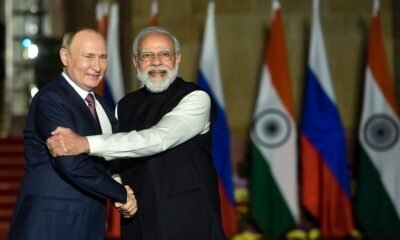Travel Guides & Articles
Putin to travel to India in December, the Kremlin says

Russian President Vladimir Putin plans to travel to India in December, the Kremlin said Friday.
Putin’s foreign affairs adviser Yuri Ushakov told reporters that the Russian leader will discuss his upcoming December visit with Indian Prime Minister Narendra Modi on Monday in China, where the two will meet on the sidelines of the annual summit of the Shanghai Cooperation Organization (SCO). The group was established by China and Russia in 2001 with a focus on security in Central Asia and the wider region.
Putin is attending the summit and holding multiple bilateral meetings on the sidelines as part of a four-day visit to China on Aug. 31 to Sept. 3. He also will hold extensive talks with Chinese leader Xi Jinping in Beijing and attend a massive military parade there commemorating the 80th anniversary of the end of World War, according to the Kremlin.
In addition meeting with Modi, the Russian leader on Monday is also scheduled to have bilateral meetings with Turkish President Recep Tayyip Erdogan and Iranian President Masoud Pezeshkian, as well as other contacts, Ushakov said.
According to Ushakov, Putin’s meeting with Modi will be the first this year, but the two “have repeatedly maintained contact by telephone.”
Modi travelled to Russia last year twice — first to Moscow for talks with Putin in July, his first trip to Russia since the full-scale invasion of Ukraine by the Kremlin’s forces in 2022, and then to Kazan in October for the summit of the BRICS bloc of developing economies.
Russia had strong ties with India during the Cold War, and New Delhi’s importance as a key trading partner with Moscow has grown since the war in Ukraine.
Modi has avoided condemning Russia while emphasizing a peaceful settlement. Their partnership has become more complicated, however, as Russia has moved closer to China amid international isolation of Moscow over Ukraine.
China and India are key buyers of Russian oil following sanctions imposed by the United States and its allies that shut most Western markets off to Russian exports.
Travel Guides & Articles
Which Is The Top Credit Card With Best Offers, Like Free Airport Lounges, Rewards And Travel Benefits? News24 –

India is seeing a steady rise in credit card usage, with banks rolling out new offers and features to attract fresh customers and persuade existing cardholders to switch. There are numerous websites and apps where customers can compare benefits, including the number of free airport lounges and travel offers, to choose the best credit card tailored to their needs. Here, we give you insight to the best credit cards that offer the most at lower fees. You can compare the benefits and choose the one. Is HDFC Regalia Gold the best?
HDFC Regalia Gold Credit Card
The HDFC Regalia Gold Credit Card is one of the most sought-after premium credit cards in India, offering a strong combination of rewards, travel perks, and lifetime benefits. However, it faces competition from several other cards that challenge its position in the market. This article examines the HDFC Regalia Gold alongside its top three competitors: SBI Card PRIME, ICICI Bank Sapphiro, and Axis Bank SELECT.
HDFC Regalia Gold Credit Card
Annual Fees and Charges
- The card has an initial and annual fee of ₹2,500 plus GST.
- The renewal fee is waived if the cardholder spends ₹4 lakh or more in a calendar year.
- The foreign currency markup is 2%, making it suitable for international transactions.
Rewards
- For every ₹150 spent on retail purchases, the cardholder earns 4 reward points.
- Purchases at partner merchants like Nykaa, Myntra, Marks & Spencer, and Reliance Digital earn 5 times the rewards (20 points per ₹150).
Airport Lounges And Other Benefits
- ₹2,500 gift voucher to the new cardholders
- ₹1 lakh spending in the initial 90 days of card issuance
- Free Swiggy One and MMT Black Elite membership
- 12 domestic airport lounge visits each year
- 6 international lounge visits via the Priority Pass membership
- ₹1,500 worth of vouchers on spending ₹1.5 lakh per quarter
- ₹5,000 worth of flight vouchers on 5 lakh spending
- Additional ₹5,000 flight vouchers on 7.5 lakh
- The card comes with full insurance coverage
- ₹1 crore air accident cover with purchase protection
- No liability for a lost card if it is reported immediately
Axis Bank SELECT
The Axis Bank SELECT card is designed for people who spend on retail. It offers high benefits for shopping and dining.
Annual Fees and Charges
- Joining fee of ₹3,000 and an equal annual fee.
- Free for Burgundy customers.
- Renewal fee is waived if annual spending reaches ₹8 lakh.
- Foreign currency markup is 3.5%.
Rewards
- Cardholders earn 10 EDGE points for every ₹200 spent.
- They earn 20 EDGE points for every ₹200 spent on retail purchases, up to ₹20,000 per month.
- Each EDGE point has a redemption value of approximately ₹0.20.
Airport Lounges And Other Benefits
- The card offers 12 international lounge visits per year through Priority Pass membership
- It also provides 2 domestic lounge visits per quarter
- Lounge access is subject to a minimum quarterly spend of ₹50,000
- New cardholders will earn 10,000 EDGE points of 2,000 in the first transaction
- The card offers 6 free golf rounds per year.
- It provides a 1% waiver on fuel surcharge for purchases between ₹400 and ₹4,000.
- Cardholders receive dining discounts through the Axis Dining Delights program.
SBI Card PRIME
Premium lifestyle credit card offering extensive travel and dining perks.
Annual Fees and Charges
- Joining fee: ₹2,999 + GST.
- Annual fee: ₹2,999 + GST (waived if annual spending reaches ₹3 lakh).
- Foreign currency markup: 3.5%.
Rewards
- Earn 2 reward points for every ₹100 spent on regular purchases.
- Earn 10 reward points for every ₹100 spent on dining, groceries, departmental stores, and movies.
- On birthdays, earn 20 reward points for every ₹100 spent.
Airport Lounges And Other Benefits
- 8 domestic lounge visits per year (2 per quarter).
- 4 international lounge visits via Priority Pass membership.
- 1% fuel surcharge waiver, up to ₹250 per month.
- 50% discount on golf games.
- 25% discount on dining through the American Express Dining Platform.
ICICI Bank Sapphiro
The ICICI Bank Sapphiro targets high spenders on travel and lifestyle.
Annual Fees and Charges:
- Joining fee: ₹6,500 + GST.
- Annual fee: ₹3,500 + GST.
- Renewal fee is waived for annual spending of ₹6 lakh.
- Foreign currency markup: 3.5%.
Rewards
- Earn 2 reward points for every ₹100 spent on domestic transactions.
- Earn 4 reward points for every ₹100 spent on international transactions.
- Milestone program: earn 4,000 points on ₹4 lakh annual spending.
- Earn 2,000 points for every additional ₹1 lakh spent after that.
Airport Lounges And Other Benefits
- 16 domestic lounge visits per year.
- 2 international lounge visits per year.
- Domestic lounge access is generous, but international access is limited.
- Welcome benefits: ₹13,000 worth of shopping and travel vouchers for new cardholders.
- Additional benefits: Up to 4 complimentary golf rounds per month on retail spending of ₹50,000 in the previous month.
(Disclaimer: The information provided about credit cards, including benefits, fees, and offers, is for general informational purposes only and may change over time. Readers should verify all details directly with the respective banks or official sources before applying or making any financial decisions)
Travel Guides & Articles
As Modi Visits China, Trump Scraps India Visit Plans For Quad Summit: NYT

US President Donald Trump no longer has plans to travel to India for the Quad Summit slated to take place later this year, reported The New York Times, quoting people familiar with the President’s schedule.
The development comes as Prime Minister Narendra Modi arrived in China to attend the Shanghai Cooperation Organisation Summit in Tianjin along with 26 other world leaders, including Russian President Vladimir Putin. New Delhi is aiming to reset ties with Beijing as diplomatic and economic relations with the US plunge over India’s oil purchases from Russia and Trump’s repeated claim of brokering the India-Pakistan ceasefire.
In a news article headlined “The Nobel Prize and a Testy Phone Call: How the Trump-Modi Relationship Unraveled”, the American newspaper discussed changing dynamics in India-US relations over the past several months.
“After telling Mr. Modi that he would travel to India later this year for the Quad summit, Mr. Trump no longer has plans to visit in the fall, according to people familiar with the president’s schedule,” the article read.
Trump had announced a tariff of 25 per cent on India, saying the country is “difficult” to trade with, and slapped another 25 per cent levy for buying oil from Russia amid the Ukraine war. The 50 per cent tariff drove India to stand alone and on top with Brazil in the list of countries that have been imposed by Trump’s tariffs. Pakistan came away with just 19 per cent.
Therefore, as relations spiral downward between India and the US, New Delhi is looking towards its neighbour, China, as well as Russia.
During his visit, Prime Minister Narendra Modi will hold separate bilateral talks with Chinese President Xi Jinping and Russian President Vladimir Putin. The talks with Xi are expected to focus on further bolstering ties between India and China, which were severed after a deadly clash between Indian and Chinese troops along the border in Galwan Valley in 2020.
Travel Guides & Articles
Donald Trump may skip Quad summit visit to India amid tensions over tariff: Report
India–United States relations appear to be entering one of their most strained phases in recent memory, with a New York Times report suggesting that President Donald Trump may no longer travel to India for the forthcoming Quad summit later this year. The Quad Summit in 2025 is scheduled to be hosted by India in New Delhi.
The Quad summit serves as a strategic platform focusing on Indo-Pacific regional security and cooperation among the United States, India, Japan, and Australia.
Once marked by bonhomie and theatrical displays of mutual admiration, the rapport between PM Narendra Modi and US President Donald Trump has likely deteriorated with surprising speed, weighed down by clashing claims on India-Pakistan tension, trade friction, and sharp disagreements on geopolitics.
Why is Trump reconsidering his India visit?
According to officials in the know cited by The New York Times, Donald Trump, who had earlier promised PM Modi a visit during the Quad summit, has quietly shelved those plans. This reversal reflects both the growing discord between the two leaders and Washington DC’s mounting frustrations with New Delhi’s independent posture on trade and energy ties with Russia.
In recent weeks, the White House has imposed successive tariffs on Indian imports, culminating in a punishing 50 percent levy—ostensibly for New Delhi’s decision to continue purchasing Russian oil.
Critics argue the sanctions are less about punishing Moscow and more about penalising India for refusing to align neatly with Trump’s narrative on India-Pakistan conflict.
What triggered the diplomatic rift between India and US?
The turning point came during a phone call in June 2025, reports NYT.
In June 2025, reportedly Donald Trump, during a call with PM Modi, claimed personal credit for ending hostilities between India and Pakistan. The US President boasted that Pakistan intended to nominate him for the Nobel Peace Prize, implying that India should follow suit.
PM Modi reportedly brusquely rejected the claim, reminding Donald Trump that the ceasefire was negotiated bilaterally without any external mediation, NYT report says.
This exchange between the leaders of India and US, seemingly minor, became emblematic of a wider erosion of trust.
For PM Modi, Trump’s repeated assertions of brokering “peace” between Delhi and Islamabad, undermined India’s long-standing policy of treating Pakistan as a strictly bilateral issue. For Donald Trump, PM Modi’s refusal to play along with his Nobel ambitions appeared as a slight, NYT report stated citing people in the know.
Are trade tensions fuelling the India-US fallout?
Trade negotiations, once heralded as a cornerstone of the India-US partnership, have ground to a halt. Donald Trump’s decision to slap a further 25 percent tariff on Indian goods, on top of existing duties, has been seen in New Delhi as outright economic bullying. An Indian official, quoted in the The New York Times report, characterised the approach as gundagardi—a colloquial term for thuggery.
The punitive measures come as India simultaneously deepens economic engagement with other partners, most notably China and Russia.
PM Modi has landed in China on Saturday, 30 August, for the SCO Summit. The Indian Prime Minister is slated to have key meetings with China’s Xi Jinping and Russia’s Vladimir Putin—an itinerary that would once have been diplomatically unthinkable at the height of the Trump–Modi camaraderie.
How is public perception shaping the India-US ties?
In India, Trump’s standing has plummeted. His effigy was paraded in Maharashtra during a festival, branded a “backstabber” by furious crowds. The deportation of Indian nationals in shackles, restrictions on H-1B visas, and tighter controls on student visas have further soured public sentiment.
Meanwhile, within Donald Trump’s political base, anti-immigrant rhetoric has found India a convenient target, despite the country’s early attempts to align with American right-wing priorities, the NYT report flags.
The sense in New Delhi is that India has been uniquely singled out, while larger buyers of Russian oil, such as China, remain untouched by equivalent tariffs.
What does this mean for India–US relations?
The seemingly souring relationship between Narendra Modi and Donald Trump represents more than a personal falling-out between two populist leaders.
It risks altering the trajectory of a strategic partnership long regarded as essential to balancing China’s rise in the Indo-Pacific. Should Trump indeed cancel his India visit, it would symbolise not merely a diplomatic slight but a deeper estrangement that could reconfigure New Delhi’s external alignments.
At stake is whether India will continue to prioritise ties with Washington DC or accelerate its rapprochement with Beijing and Moscow. With both countries now engaging in sharp rhetoric, the coming months may determine whether the world’s largest and oldest democracies can salvage their partnership—or whether the Trump–Modi rift marks the start of a more profound geopolitical realignment.
-
Tools & Platforms3 weeks ago
Building Trust in Military AI Starts with Opening the Black Box – War on the Rocks
-

 Ethics & Policy1 month ago
Ethics & Policy1 month agoSDAIA Supports Saudi Arabia’s Leadership in Shaping Global AI Ethics, Policy, and Research – وكالة الأنباء السعودية
-

 Events & Conferences3 months ago
Events & Conferences3 months agoJourney to 1000 models: Scaling Instagram’s recommendation system
-

 Jobs & Careers2 months ago
Jobs & Careers2 months agoMumbai-based Perplexity Alternative Has 60k+ Users Without Funding
-

 Funding & Business2 months ago
Funding & Business2 months agoKayak and Expedia race to build AI travel agents that turn social posts into itineraries
-

 Education2 months ago
Education2 months agoVEX Robotics launches AI-powered classroom robotics system
-

 Podcasts & Talks2 months ago
Podcasts & Talks2 months agoHappy 4th of July! 🎆 Made with Veo 3 in Gemini
-

 Business1 day ago
Business1 day agoThe Guardian view on Trump and the Fed: independence is no substitute for accountability | Editorial
-

 Podcasts & Talks2 months ago
Podcasts & Talks2 months agoOpenAI 🤝 @teamganassi
-

 Mergers & Acquisitions2 months ago
Mergers & Acquisitions2 months agoDonald Trump suggests US government review subsidies to Elon Musk’s companies





















